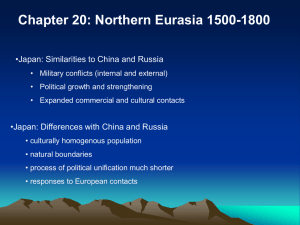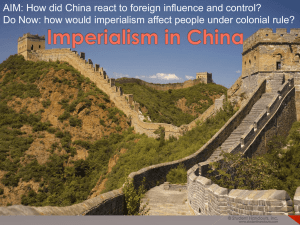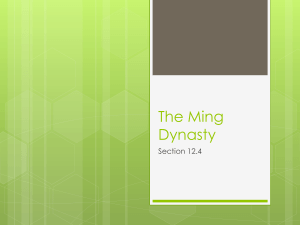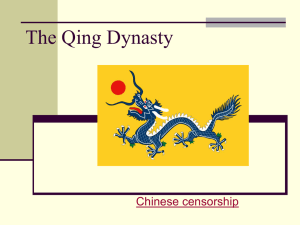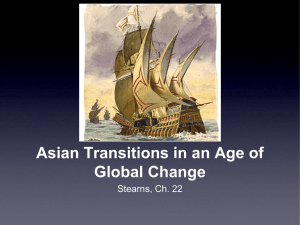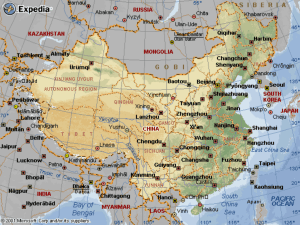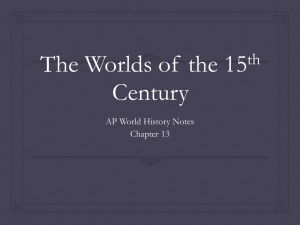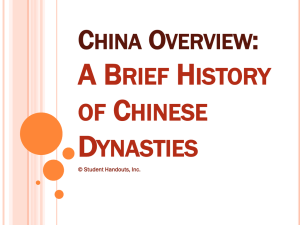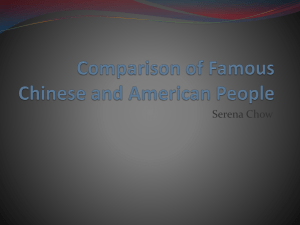Lecture Powerpoint
advertisement
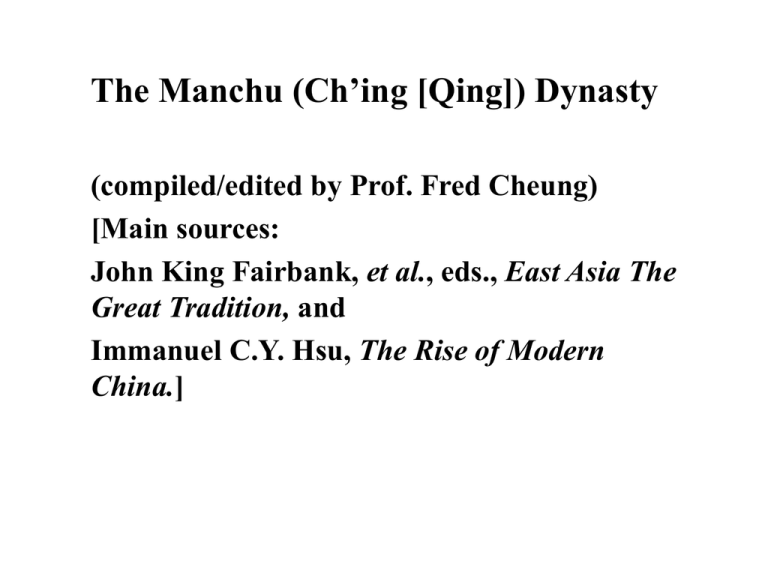
The Manchu (Ch’ing [Qing]) Dynasty (compiled/edited by Prof. Fred Cheung) [Main sources: John King Fairbank, et al., eds., East Asia The Great Tradition, and Immanuel C.Y. Hsu, The Rise of Modern China.] • The Manchu (Ch’ing [Qing]) Dynasty witnessed both the zenith and the dark side of Imperial Chinese history: in the eighteenth century, the population and territory of the Chinese Empire were the largest they had ever been; yet the nineteenth century brought disasters internally and especially externally. • The success story of the Manchus was like that of the Mongols under Genghis Khan: a powerful leader united his people, set them on the march, won on the horseback, and ruled China. • The Creation of a Sinicized Manchu State. • Nurhachi (1559-1626), the founder of the Manchu state, followed the tradition of Genghis Khan in fighting his way to power on the pretext of avenging the deaths of his father and grandfather. Nurhachi is said to have mobilized his family and tribe and exterminated his rivals by 1586. He fortified his home and married the daughter of one powerful chief and the granddaughter of another. Through 30 years of negotiation, political marriages and alliances, and warfare, Nurhachi united the 4 main Jurchen tribes to the north and rose to power. • Then, Nurhachi concentrated on uniting his own people. His greatest achievement was to develop new administrative institutions, especially the “Banner” system, which came into being gradually after 1601. 300 warriors were grouped at first under 4 banners, colored yellow, white, blue, and red. 4 more were later added, of the same colors but bordered with red, except for the red banner, which was bordered with white. • Under these 8 banners, all the tribesmen were enrolled and thus a transition was made from tribal to bureaucratic organization. • In 1618, Nurhachi openly attacked the Ming Dynasty, took part of Liaotung, and developed a civil administration. In 1625, Nurhachi moved his Capital to Mukden. After his death in 1626, he was given the title of T’ai Tsu (Grand Progenitor). He was followed by capable successors: his 8th son: Abahai (1592-1643), and especially his 14th son: Dorgon (1612-1650), who dutifully refused the imperial title in favor of a 6-year-old young nephew [Shun-chih, [r. 1644-1661], but actually ruled as Regent; and finally, Nurhachi’s great grandson: the K’ang-hsi Emperor, under whose 61-year reign from 1661 to 1722, the Manchu Dynasty was firmly established. • In 1627, Abahai attacked Korea, and again in 163-1637, making it a vassal state. He defeated the Inner Mongols and made them his vassals, too. In 1636, Abahai renamed his Dynasty the Ch’ing (“Pure”). • General Wu San-kuei (1612-1678) [& Chen Yuan-yuan] • Rebel Li Tzu-ch’eng • Emperor K’ang-hsi (r. 1661-1722) • K’ang-hsi’s main ideological success was with the Chinese scholars. He himself was well versed in the Classics and had strong intellectual interests. • In 1679, K’ang-hsi held a special examination to select the compilers of the Ming History and succeeded in getting 152 top scholars to take it, out of 188 whom he invited. • He also selected Chinese scholars, calligraphers, and artists to serve within the palace. Important works were produced under his patronage, often with a preface by him. These included the famous K’ang-hsi Dictionary, an administrative geography of the Empire, and the complete works of Chu Hsi. • He also supported a massive encyclopedia, Synthesis of Books and Illustrations of Ancient and Modern Times (Ku-chin t’u-shu chi-ch’eng), • Thus, K’ang-hsi had become an ardent and great patron of scholarship. • Much of the intellectual activity of the 18th century was carried on in the shadow of the imperial institution. • Emperor Yung-cheng (r. 1723-1735) subsidized academies to give employment to scholars. • Emperor Ch’ien-lung (r. 1736-1795) [held power for 63 years] sponsored 57 large publications compiled by a host of learned editors. • In 1773, Tai Cheng was one of the leading scholars appointed by Emperor Ch’ienlung to compile a great imperial manuscript library called The Complete Library of the Four Treasures (Ssu-k’u ch’uen-shu), that is, the 4 branches of literature --- the Classics, history, philosophy, and belles-lettres. • Military Deterioration • Certain signs of decline had appeared by 1800: • military ineffectiveness of the banner forces, • corruption at the top of the bureaucracy, and • difficulties of livelihood among a greatly increased population. • The White Lotus Rebellion • Population growth • The official population estimates record a yearby-year increase: • In 1741 142 million • In 1851 432 million • In an ancient and thickly populated agricultural state like China in the 18th-19th centuries, the population growth eventually destroyed both the prosperity and the peace, which had made it possible. • Early Western Contact • The Rise of Great Nations • The Portuguese adventurers • The Jesuit Success Story • “God, Gold, Glory” theory • During the decline of the Ming Dynasty and the Manchu’s conquest, some Jesuit missionaries came to China, and they became well versed in Chinese culture, secured the patronage of high officials, and even gained court positions at Peking. • The greatest of these Jesuit pioneers, Matteo Ricci (1552-1610) was assigned to China in 1582. Ricci was an Italian of impressive personality, with beard and blue eyes, … They adopted Chinese forms as far as possible –- they dress in Confucian scholar’s gown. Instead of preaching, they held conversations with Chinese scholars, arousing their curiosity with demonstrations of prisms, clocks, and geographical knowledge. • The Jesuits became fluent in Mandarin and literate in Chinese Classics. This enabled Ricci to represent Christianity as a system of wisdom and ethics compatible with Han Confucianism. • Map of the world with China in the middle –- the Middle Kingdom • Ricci’s successors (the later Jesuits) found that they could make themselves most useful by applying their Western knowledge of astronomy to the revision of the Chinese calendar. • In 1622, Johannes Adam Schall von Bell (1591-1666), a German Jesuit, came to China. He was a knowledgeable astronomer and he secured a position in the palace, where he celebrated mass in 1632. • The combination of western science and Christian moral teachings (some of which, such as love, kindness, humanity, benevolence, are similar to Confucianism) attracted a number of outstanding converts, who were capable of collaborating in truly bicultural endeavors. • The most outstanding convert was Hsu Kuang-chi (Paul, Christian name, 15621633), who became a Christian even before he passed the highest examination and entered the Hanlin Academy in 1604. • With Ricci, Hsu completed the translation of the first 6 books of Euclid’s geometry. • In 1632, Hsu was made a Grand Secretary. • Both Hsu and Adam Schall also helped the Ming court obtain western military arms. • In 1636, Adam Schall cast some 20 big guns (canons) to fight off the Manchus. • In short, western technology gained acceptance more readily than western religion. • After the conquest of 1644, the Manchu kept Adam Schall as chief astronomer. • The young emperor saw him very often, and even called him “Grandpa”, and permitted the building of a Christian church at Peking. During the long reign of K’ang-hsi, the Jesuit mission at Peking reached the height of its influence. Their position was that of courtiers to the emperor. • The Jesuits were pioneers in contact between 2 great cultures. Unfortunately, facing 2 ways, they eventually suffered attack on both fronts. However, the main attack came from their European competitors. • The image of China conveyed through the influential Jesuit writings from Peking figured in the Enlightenment as an example of an ancient society, which had a natural morality. In the philosophical debate over the relationship between morality and religion, the China depicted by the Jesuits was cited approvingly by Voltaire especially (who gave Confucius and Mencius their Latinized names after reading their books). • Furthermore, 18th century Europe enjoyed Chinese things, not only an idealized image of rational Confucian ethics and benevolent despotism in government but also a craze of Chinese things, such as the Chinese style in architecture, porcelain, furniture, and decoration (in addition to tea and spice). • At Peking, the Jesuits continued to serve as astronomers, interpreters, painters, architects, and engineers. But the Jesuits were missionaries, and their effort to apply the universal principles of Christianity to the realities of China led them into the path of cultural accommodation –- in short, Sinification. • Actually, accommodation had been the secret of the Jesuit success in China. • As Paul Hsu put it, Christianity “does away with Buddhism and completes Confucianism” (Fairbank, p. 249). Christian faith could be added to Confucian practice. • The Jesuit compromise met with challenges, especially in the ritual problems such as ancestral worship. To some theologians, the Chinese ancestral worship was not simple civil rite but pagan worship, which could not be allowed in monotheistic Christianity. So, some theologians believed that the Jesuits’ compromise went too far, that in making Christianity acceptable to Chinese classical scholars, the early Jesuits had destroyed its essential monotheistic principles of faith. • By the 1640s, the controversy over the rites to be permitted had been referred to Rome by mendicant friars of the Dominicans and Franciscan orders. • The Rites Controversy boiled along for a century (1640-1742), both within and between the various Catholic orders and missions in China and their supporters in Europe, eventually even between the Pope and the Ch’ing Emperor. • The Confucian scholars’ hostility to Christianity was based on the following points: • 1. Rational skepticism about such doctrines as original sin, the virgin birth, and the divinity of Jesus; • 2. A defense of Taoism, Buddhism, and the Confucian teachings; and • 3. Xenophobic emotion and cultural pride; etc. • Invasion and rebellion in 19th-century China • Traditional China’s resistance to change • The ruling class and its agrarian outlook and thinking • The inertia of government –- stability for too long –- conservative • Corruption • China’s image of the west --- the barbarians paying tribute to the Middle Kingdom • Imbalance of trade –- the rise of the opium trade • God, Gold, Glory theory • The Opium War, 1839-1842 • The Treaty of Nanking, 1842 • Difference in cultures and in legal concepts/procedures • The Anti-Opium movement • Commissioner Lin Tse-hsu (1785-1850) at Canton • The first treaty settlement • Treaty ports: Canton, Amoy, Foochow, Ningpo, and Shanghai • Western influence through the treaty ports • The rise of rebellions • The Taiping Kingdom • The Nien and Muslim rebellions • China’s response to the west • The T’ung-chih Restoration (cf. Japanese Meiji Restoration?) • (Mary Wright, The Last Stand of Chinese Conservatism [just white-washing]) • • • • • • • • • • • • The Ch’ing Dynasty (1644-1911) Emperors Reign period Shun-chih 1644-1661 K’ang-hsi 1662-1722 Yung-cheng 1723-1735 Ch’ien-lung 1736-1795 Chia-ch’ing 1796-1820 Tao-kuang 1821-1850 Hsien-feng 1851-1861 T’ung-chih 1862-1874 Kuang-hsu 1875-1908 Hsuan-t’ung 1909-1911

